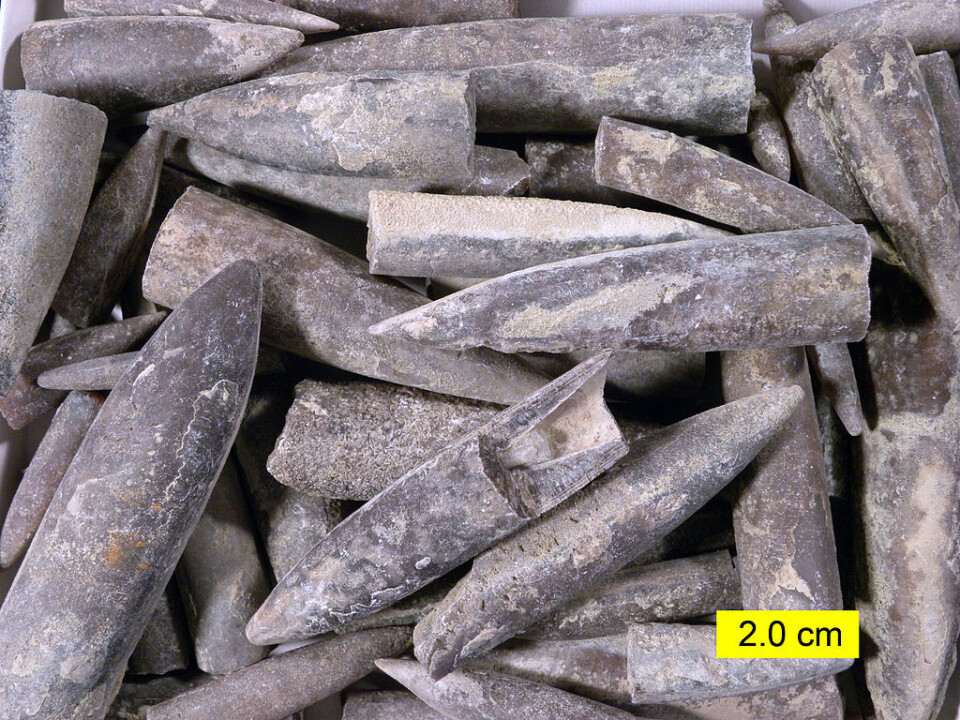
How ancient squids survived extreme climate change
Scientists have uncovered how ancient squid-like animals survived dramatic climate changes not unlike those we see today.
183 million years ago the Earth’s climate change dramatically and the basis for life for many animals deteriorated or disappeared completely within a short time period.
Volcanoes exploded and sent gigantic amounts of CO2 into the atmosphere, methane streamed up from oceans derived of oxygen, and the temperature rose drastically.
Now, new Danish research shows how some animals adapted to the dramatic climate changes.
Belemnites, an extinct cousin to modern squids, adapted relatively quickly to a life away from the oxygen-poor sea-¬bed by moving to the surface of the ocean. Here they had to acclimatise themselves to living with higher temperatures and new forms of food -- and they did. So the ancient squids survived.

Scientists can use the discovery to better understand the challenges that today's animal life must overcome because of future climate changes, and how they may adapt.
"The climate changes 183 million years ago closely resemble the climate changes we see today," says study co-author Clemens Vinzens Ullmann, postdoc at the University of Copenhagen's Department of Geosciences and Natural Resource Management. "When we look at how life forms adapted to the climate then, we can get a broad idea of the direction that life forms may take in their development in the future. This means we’ll be better able to inform decision-makers about how the future may look."
The study was recently published in PNAS.
Volcanoes started the climate changes
Before continuing with the results of the new study, we must look at what researchers believe happened 183 million years ago when the climate changed so dramatically.
Firstly, the climate changes occurred at the same time as volcanic activity in South Africa, South America and Antarctica. This led to the release of massive amounts of CO2 which created a greenhouse effect and raised the surface temperature on Earth.
Over time, the changed climate destabilised the sea-bed caused the release of methane. This is a very potent greenhouse gas and the release of methane caused the temperature to rise by another five to six degrees Celsius above the normal temperature.
At the same time, algae growth created large amounts of dead organic material that bacteria consumed on the sea-bed, using up all the oxygen in the process.
Thus we had a situation 183 million years ago when the oceans hadmsuddenly become warmer and deprived of oxygen -- in no way were these optimal conditions for animals that had adapted to cooler temperatures and needed oxygen.
"The climate changes meant that many animals on the sea-bed, such as mussels and sea-snails, died because of a lack of oxygen," says Ullmann. "Mobile animals had to find new habitats in order to survive. With this study we wanted to find out how the animals adapted to the changing climate."
Belemnites changed habitat
In their study, the researchers looked at the isotope composition of mineral calcium in belemnites.
Some belemnites fossils are of animals that lived 183 million years ago and they open a window into that period.
Some species of belemnites became extinct during the climate changes, while other species arose; by studying the composition of mineral calcium in belemnites from different species the researchers could determine the depths where the belemnites lived in the water before and during the climate changes.
How they did it:
Belemnites contain two types of material containing carbon -- inorganic calcium and organic materials such as proteins.
In addition, the carbonaceous materials from the period are made up of compositions of light and heavy carbons – partly because photosynthesising organisms such as algae prefer light carbons which they incorporate in CO2.
When the researchers looked at the difference in the isotope compositions of the carbon in the organic and inorganic material of the belemnites, they found a larger amount of heavy carbons in the belemnites than they had expected.
In other words, the belemnites lived higher up in the water than the researchers believed. According to the researchers, the ratio between heavy and light carbons high in the water is different from the ratio at the sea-bed -- because there were algae at the surface and they extracted the light carbons from the water, leaving the heavy carbons to the belemnites.
"Our analysis shows how the belemnites fled higher up in the water as the climate changed," says Ullmann. "That was their strategy for survival. It also meant they had to find new forms of food, as they presumably fed on mussels and sea-snails on the sea-bed before the climate changed. Perhaps they started to feed on small fish instead."
Oxygen shows temperature difference
The scientists have also compared their carbon analyses with analyses of oxygen isotopes in the belemnite fossils.
Those isotopes can reveal how warm the climate was in the period when a fossil was formed.
Earlier studies of oxygen isotopes have shown that the belemnites experienced a rise in temperature of 15 to 16 degrees from just before to during the climate changes.
Up to now, this large temperature difference has been difficult for scientists to explain but the new study makes this possible:
"That the sea temperature should have risen by 15-16 degrees is absurd -- it's far too much," says Ullmann. "Our studies show that a large part of the temperature difference came about because the belemnites started to live higher in the water, where the temperature was higher than it was at the sea-bed. A rise of only about five or six degrees is due to a higher temperature in the sea itself."
Ullmann adds that the evolutionary development must have been very fast for the belemnites to have adapted themselves to the changing climate.
This is why the new knowledge can be used to estimate how quickly today's animals can and must adapt to the ongoing climate changes.
Mankind has suspended natural processes
Professor Jens-Christian Svenning at the Institute for Bioscience at Aarhus University calls the study very interesting as it looks at an area that scientists generally tend to ignore.
"We have this amazing past which we can learn from," says Svenning. "So it’s important that we study events in the past that resemble events that occur today. This is something this study does in a wonderful way."
However, Svenning warns about differences in the time perspective in the present climate situation and the events that took place 183 million years ago.
"You must remember that we often look at today's climate changes and their consequences in very short perspectives," says the professor.
"Generally we would like to know what will happen in 50 to 200 years' time, as this is relevant to society today. This study deals with far longer time periods and we must remember that,” he says. “Events like those that occurred then may occur again, but the development of new species in particular after a period of widespread extinction is not something that will take place over a couple of hundred years."
Svenning also points out that there is a difference between then, when everything was natural, and now, when mankind has suspended some of the natural processes.
----
Read the original story in Danish on Videnskab.dk
Translated by: Michael de Laine







